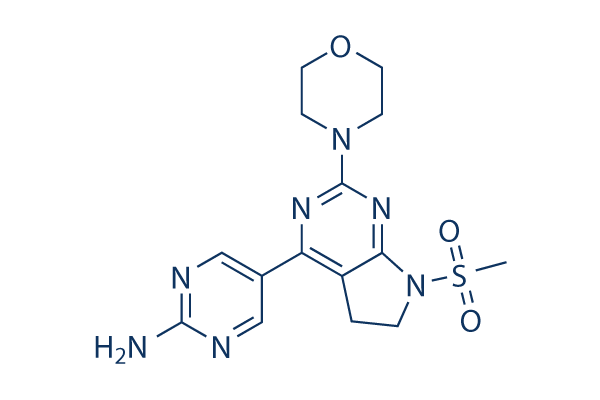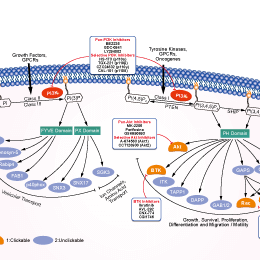
- Bioactive Compounds
- By Signaling Pathways
- PI3K/Akt/mTOR
- Epigenetics
- Methylation
- Immunology & Inflammation
- Protein Tyrosine Kinase
- Angiogenesis
- Apoptosis
- Autophagy
- ER stress & UPR
- JAK/STAT
- MAPK
- Cytoskeletal Signaling
- Cell Cycle
- TGF-beta/Smad
- DNA Damage/DNA Repair
- Compound Libraries
- Popular Compound Libraries
- Customize Library
- Clinical and FDA-approved Related
- Bioactive Compound Libraries
- Inhibitor Related
- Natural Product Related
- Metabolism Related
- Cell Death Related
- By Signaling Pathway
- By Disease
- Anti-infection and Antiviral Related
- Neuronal and Immunology Related
- Fragment and Covalent Related
- FDA-approved Drug Library
- FDA-approved & Passed Phase I Drug Library
- Preclinical/Clinical Compound Library
- Bioactive Compound Library-I
- Bioactive Compound Library-Ⅱ
- Kinase Inhibitor Library
- Express-Pick Library
- Natural Product Library
- Human Endogenous Metabolite Compound Library
- Alkaloid Compound LibraryNew
- Angiogenesis Related compound Library
- Anti-Aging Compound Library
- Anti-alzheimer Disease Compound Library
- Antibiotics compound Library
- Anti-cancer Compound Library
- Anti-cancer Compound Library-Ⅱ
- Anti-cancer Metabolism Compound Library
- Anti-Cardiovascular Disease Compound Library
- Anti-diabetic Compound Library
- Anti-infection Compound Library
- Antioxidant Compound Library
- Anti-parasitic Compound Library
- Antiviral Compound Library
- Apoptosis Compound Library
- Autophagy Compound Library
- Calcium Channel Blocker LibraryNew
- Cambridge Cancer Compound Library
- Carbohydrate Metabolism Compound LibraryNew
- Cell Cycle compound library
- CNS-Penetrant Compound Library
- Covalent Inhibitor Library
- Cytokine Inhibitor LibraryNew
- Cytoskeletal Signaling Pathway Compound Library
- DNA Damage/DNA Repair compound Library
- Drug-like Compound Library
- Endoplasmic Reticulum Stress Compound Library
- Epigenetics Compound Library
- Exosome Secretion Related Compound LibraryNew
- FDA-approved Anticancer Drug LibraryNew
- Ferroptosis Compound Library
- Flavonoid Compound Library
- Fragment Library
- Glutamine Metabolism Compound Library
- Glycolysis Compound Library
- GPCR Compound Library
- Gut Microbial Metabolite Library
- HIF-1 Signaling Pathway Compound Library
- Highly Selective Inhibitor Library
- Histone modification compound library
- HTS Library for Drug Discovery
- Human Hormone Related Compound LibraryNew
- Human Transcription Factor Compound LibraryNew
- Immunology/Inflammation Compound Library
- Inhibitor Library
- Ion Channel Ligand Library
- JAK/STAT compound library
- Lipid Metabolism Compound LibraryNew
- Macrocyclic Compound Library
- MAPK Inhibitor Library
- Medicine Food Homology Compound Library
- Metabolism Compound Library
- Methylation Compound Library
- Mouse Metabolite Compound LibraryNew
- Natural Organic Compound Library
- Neuronal Signaling Compound Library
- NF-κB Signaling Compound Library
- Nucleoside Analogue Library
- Obesity Compound Library
- Oxidative Stress Compound LibraryNew
- Plant Extract Library
- Phenotypic Screening Library
- PI3K/Akt Inhibitor Library
- Protease Inhibitor Library
- Protein-protein Interaction Inhibitor Library
- Pyroptosis Compound Library
- Small Molecule Immuno-Oncology Compound Library
- Mitochondria-Targeted Compound LibraryNew
- Stem Cell Differentiation Compound LibraryNew
- Stem Cell Signaling Compound Library
- Natural Phenol Compound LibraryNew
- Natural Terpenoid Compound LibraryNew
- TGF-beta/Smad compound library
- Traditional Chinese Medicine Library
- Tyrosine Kinase Inhibitor Library
- Ubiquitination Compound Library
-
Cherry Picking
You can personalize your library with chemicals from within Selleck's inventory. Build the right library for your research endeavors by choosing from compounds in all of our available libraries.
Please contact us at [email protected] to customize your library.
You could select:
- Antibodies
- Bioreagents
- qPCR
- 2x SYBR Green qPCR Master Mix
- 2x SYBR Green qPCR Master Mix(Low ROX)
- 2x SYBR Green qPCR Master Mix(High ROX)
- Protein Assay
- Protein A/G Magnetic Beads for IP
- Anti-Flag magnetic beads
- Anti-Flag Affinity Gel
- Anti-Myc magnetic beads
- Anti-HA magnetic beads
- Magnetic Separator
- Poly DYKDDDDK Tag Peptide lyophilized powder
- Protease Inhibitor Cocktail
- Protease Inhibitor Cocktail (EDTA-Free, 100X in DMSO)
- Phosphatase Inhibitor Cocktail (2 Tubes, 100X)
- Cell Biology
- Cell Counting Kit-8 (CCK-8)
- Animal Experiment
- Mouse Direct PCR Kit (For Genotyping)
- New Products
- Contact Us
CH5132799
Synonyms: MEN1611, PA799
CH5132799 (MEN1611, PA799) inhibits class I PI3Ks, particularly PI3Kα with IC50 of 14 nM; less potent to PI3Kβδγ, while sensitive in PIK3CA mutations cell lines. Phase 1.

CH5132799 Chemical Structure
CAS No. 1007207-67-1
Purity & Quality Control
Batch:
Purity:
99.67%
99.67
CH5132799 Related Products
Signaling Pathway
Biological Activity
| Description | CH5132799 (MEN1611, PA799) inhibits class I PI3Ks, particularly PI3Kα with IC50 of 14 nM; less potent to PI3Kβδγ, while sensitive in PIK3CA mutations cell lines. Phase 1. | ||||||||
|---|---|---|---|---|---|---|---|---|---|
| Targets |
|
| In vitro | ||||
| In vitro | CH5132799 selectively inhibits class I PI3Ks, PI3Kα (IC50 = 0.014 μM ), PI3Kβ (IC50 = 0.12 μM ), PI3Kδ (IC50 = 0.50 μM ), PI3Kγ (IC50 = 0.036 μM ), but shows less inhibition of class II PI3Ks, class III PI3k and mTOR and also no inhibitory activity (IC50 > 10 μM) against 26 protein kinases. CH5132799 exhibits more inhibitory activities against PI3Kα with oncogenic mutations E542K (IC50 = 6.7 nM), E545K (IC50 = 6.7 nM) and H1047R (IC50 = 5.6 nM) than wild-type PI3Kα. CH5132799 treated breast cnacer KPL-4 cells, which harbor the PIK3CA mutation, phosphorylation of Akt and its direct substrates, PRAS40 and FoxO1/3a and phosphorylation of downstream factors, including S6K, S6 and 4E-BP1, are effectively suppressed. Cancer cell lines harboring PIK3CA mutations are significantly sensitive to CH5132799 [1] In human tumor cell lines with PI3K pathway activation by mutation, CH5132799 shows potent antiproliferative activity [HCT116(CRC): IC50 = 0.20 lM, KPL-4(BC):13 IC50 = 0.032 lM, T-47D(BC): IC50 = 0.056 lM, SK-OV-3(Ovarian): IC50 = 0.12 lM]. CH5132799 effectively suppresses phosphorylation of AKT in KPL-4 cells. [2] | |||
|---|---|---|---|---|
| Kinase Assay | PI3K Assay | |||
| The E542K, E545K, and H1047R mutants of PI3Kα are prepared with an overlapped extension-polymerase chain reaction. Glutathione S-transferase-tagged PI3Kα mutants and His-tagged p85α are co-expressed with BAC-TO-BAC Baculovirus Expression System. The inhibitory activities of CH5132799 on PI3Kα (p110α/p85α), PI3Kβ(p110β/p85α), PI3Kδ (p110δ/p85α), PI3Kγ (p110γ), PI3KC2α, PI3KC2β, Vps34, and PI3Kα mutants are determined by Adapta Universal Kinase Assay Kit. Time-resolved fluorescence is measured with an EnVision HTS microplate reader. IC50 values are calculated using XLfit. | ||||
| Cell Research | Cell lines | various cancer cell lines belonging to 4 types of cancer—breast, ovarian, prostate, and endometrial cancer—in which the PIK3CA mutation and PTEN deficiency are frequently found and in which RAS/RAF is rarely mutated | ||
| Concentrations | 0 - 10μM | |||
| Incubation Time | 4 days | |||
| Method | The cell lines are added to the wells of 96-well plates containing 0.076 to 10,000 nM CH5132799 and incubated at 37 °C. After 4 days of incubation, Cell Counting Kit-8 solution is added and, after incubation for several more hours, absorbance at 450 nm is measured with Microplate-Reader iMark. The antiproliferative activity is calculated by the formula (1- T/C) × 100 (%), in which T and C represent absorbance at 450 nm of the cells treated with CH5132799 (T) and that of untreated control cells (C). The IC50 values are calculated by using Microsoft Excel 2007. |
|||
| In Vivo | ||
| In vivo | CH5132799 shows potent in vivo antitumor activity in several different xenograft models with PIK3CA mutations. CH5132799 overcomes mTORC1 inhibition-mediated Akt activation and regrowth of xenograft tumor by long-term everolimus administration. [1] CH5132799 as a clinical candidate that shows excellent oral bioavailability (BA) (101% in mouse), human liver microsomal stability and in vivo antitumor activity in the PC-3 xenograft model (TGI: 101% at 25 mg/kg, po, q.d. × 11 days). CH5132799 exhibits good oral BA in mouse, rat, monkey and dog (F: 54.2-101%). In a human breast cancer (KPL-4: PI3Ka H1047R) xenograft model in mice, oral treatment with CH5132799 (12.5 mg/kg, q.d.) shows strong tumor regression. The strong regression is maintained during the 6 week administration, even in the intermittent dosing schedule (q.d., 2 weeks on/1 week off; q.d., 5 days on/2 days off), suggesting that a flexible administration schedule can be applicable in the clinic. [2] | |
|---|---|---|
| Animal Research | Animal Models | A total of 4 × 106 to 1.2 × 107 cells are injected subcutaneously into the right flank of female BALB-nu/nu mice. |
| Dosages | 0.39, 0.78, 1.56, 3.13, 6.25, 12.5 and 25 mg/kg | |
| Administration | Orally administered once a day. | |
| NCT Number | Recruitment | Conditions | Sponsor/Collaborators | Start Date | Phases |
|---|---|---|---|---|---|
| NCT01222546 | Completed | Solid Tumors |
Chugai Pharma Europe Ltd. |
August 2010 | Phase 1 |
Chemical Information & Solubility
| Molecular Weight | 377.42 | Formula | C15H19N7O3S |
| CAS No. | 1007207-67-1 | SDF | Download CH5132799 SDF |
| Smiles | CS(=O)(=O)N1CCC2=C(N=C(N=C21)N3CCOCC3)C4=CN=C(N=C4)N | ||
| Storage (From the date of receipt) | |||
|
In vitro |
DMSO : 12 mg/mL ( (31.79 mM) Moisture-absorbing DMSO reduces solubility. Please use fresh DMSO.) Water : Insoluble Ethanol : Insoluble |
Molecular Weight Calculator |
|
In vivo Add solvents to the product individually and in order. |
In vivo Formulation Calculator |
||||
Preparing Stock Solutions
Molarity Calculator
In vivo Formulation Calculator (Clear solution)
Step 1: Enter information below (Recommended: An additional animal making an allowance for loss during the experiment)
mg/kg
g
μL
Step 2: Enter the in vivo formulation (This is only the calculator, not formulation. Please contact us first if there is no in vivo formulation at the solubility Section.)
% DMSO
%
% Tween 80
% ddH2O
%DMSO
%
Calculation results:
Working concentration: mg/ml;
Method for preparing DMSO master liquid: mg drug pre-dissolved in μL DMSO ( Master liquid concentration mg/mL, Please contact us first if the concentration exceeds the DMSO solubility of the batch of drug. )
Method for preparing in vivo formulation: Take μL DMSO master liquid, next addμL PEG300, mix and clarify, next addμL Tween 80, mix and clarify, next add μL ddH2O, mix and clarify.
Method for preparing in vivo formulation: Take μL DMSO master liquid, next add μL Corn oil, mix and clarify.
Note: 1. Please make sure the liquid is clear before adding the next solvent.
2. Be sure to add the solvent(s) in order. You must ensure that the solution obtained, in the previous addition, is a clear solution before proceeding to add the next solvent. Physical methods such
as vortex, ultrasound or hot water bath can be used to aid dissolving.
Tech Support
Answers to questions you may have can be found in the inhibitor handling instructions. Topics include how to prepare stock solutions, how to store inhibitors, and issues that need special attention for cell-based assays and animal experiments.
Tel: +1-832-582-8158 Ext:3
If you have any other enquiries, please leave a message.
* Indicates a Required Field
Tags: buy CH5132799 | CH5132799 supplier | purchase CH5132799 | CH5132799 cost | CH5132799 manufacturer | order CH5132799 | CH5132799 distributor







































